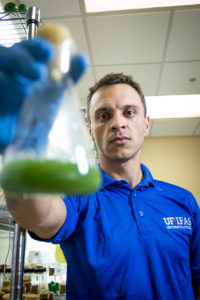UF scientists show how long toxins produced by HABs of blue-green algae remain in the air
By: Lourdes Rodriguez
 DAVIE, Fla. — Rivers, lakes, and ponds are recreational destinations for swimming, fishing, boating and more. When cyanobacterial harmful algal blooms (cyanoHABs) form releasing toxins into these freshwater systems, there can be harmful impacts to all wildlife and humans creating symptoms such as nausea, skin and eye irritations, tumor production, and in some cases even death.
DAVIE, Fla. — Rivers, lakes, and ponds are recreational destinations for swimming, fishing, boating and more. When cyanobacterial harmful algal blooms (cyanoHABs) form releasing toxins into these freshwater systems, there can be harmful impacts to all wildlife and humans creating symptoms such as nausea, skin and eye irritations, tumor production, and in some cases even death.
Cyanobacteria are a blooming problem across the country, and while there is information available on how toxins act in the water, there is limited information available on how the toxins progress in the air, until now.
A team of scientists at the University of Florida took the first steps by looking at how one of the most widespread and prevalent cyanobacterial toxins, known as microcystin-LR, reacts in the air and for how long.
“Research on public and environmental health threats and dynamics of microcystins in aquatic systems has been going on for decades. However, in comparison, there are only a few studies on the dynamics of this toxin in the air,” said H. Dail Laughinghouse IV, a co-author of the study and UF/IFAS assistant professor of applied phycology and Extension specialist in HABs who is based at the UF/IFAS Fort Lauderdale Research and Education Center.
The study’s lead author, Myoseon Jang, a UF associate professor in environmental engineering sciences based in Gainesville at the Herbert Wertheim College of Engineering was joined by Laughinghouse and five other scientists taking an extensive look at what environmental conditions in the air influence the toxin causing it to deteriorate and spread at varying rates. The study also looked at the potential for microcystin-LR to impact neighboring communities as it mixes, or aerosolizes, in the air. For researchers and those who regularly recreate, work, or live near these freshwater bodies experiencing HABs, this is vital information.
The results, published in a recent edition of Environmental Sciences & Technology Letters, unveiled information about the toxin’s potential and lasting effects during varying times of the day and night.
“Due to the potential public health threat of exposure via aerosolized forms through water spray, understanding the way the toxin acts in the air, and how long it remains viable, is vital,” added Laughinghouse.
For the study, the team conducted several experiments using state-of-the-art technology at Jang’s lab and developed at UF known as the Atmospheric Photochemical Outdoor Reactor. The device, which looks like a greenhouse, measures how the toxin reacts, progresses, and decays in a variety of meteorological conditions including ranges of sunlight, humidity, ozone and other gasses.
The team found that the estimated lifetime of microcystin in the air at typical day ozone concentrations can be about two hours. However, the team also learned that the toxin’s reaction varied across atmospheric conditions and consistently decayed quicker when exposed to ambient sunlight. The degree of decay was dependent on the quantity of oxidants such as ozone and hydroxyl radicals in the air that increases with intensity of the sunlight and the amount of air pollutants such as hydrocarbon and nitrogen oxides emitted from human activities.
Based on the chamber study, while airborne algal toxins can rapidly decay in air, residential areas within about 10 miles from a cyanobacterial bloom source could be impacted by the harmful algal aerosols even under a gentle breeze traveling four to seven miles per hour.
“These data can assist in producing a model for predicting the longevity of aerosolized algal toxins and the study of airborne algal toxins in the field,” said Jang. “As long as HAB breaks, toxic algae aerosol can be created by the bursting of air bubbles, which are aroused by winds on the surface of fresh water. Hence, the impact of algal aerosol on human health and environments can be continued until harmful algal blooms are recessed.”
Others participating in the study were David E. Berthold, a biological scientist and lab manager at UF/IFAS Fort Lauderdale Research and Education Center, Nancy D. Denslow, a professor of physiological sciences in the department of physiological sciences and Center for Environmental and Human Toxicology in Gainesville, Cecilia Silva-Sanchez, a UF scientific lab manager at the Center for Environmental and Human Toxicology, and Zechen Yu and Sanghee Han, researchers of environmental engineering sciences.
[livemarket market_name="KONK Life LiveMarket" limit=3 category=“” show_signup=0 show_more=0]

No Comment